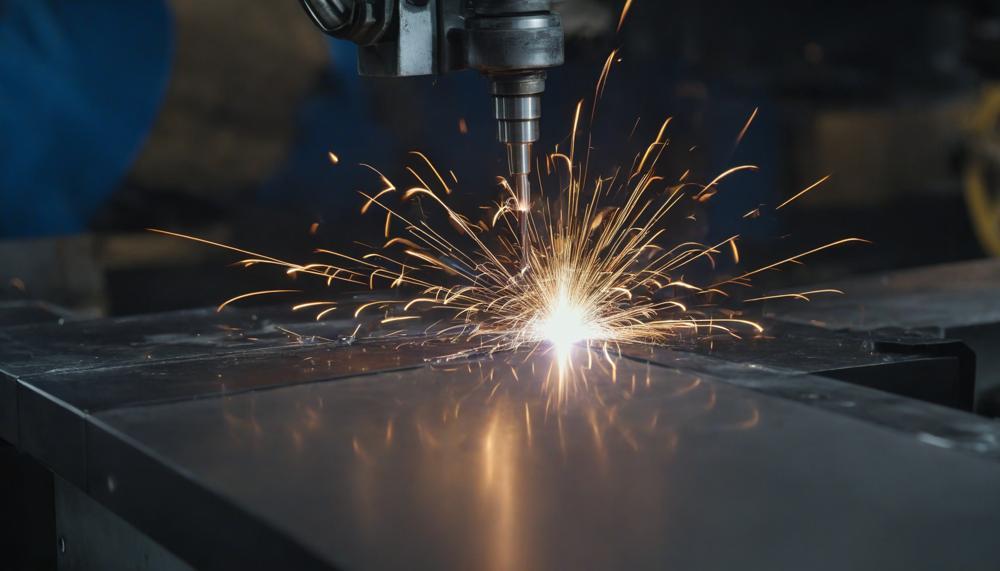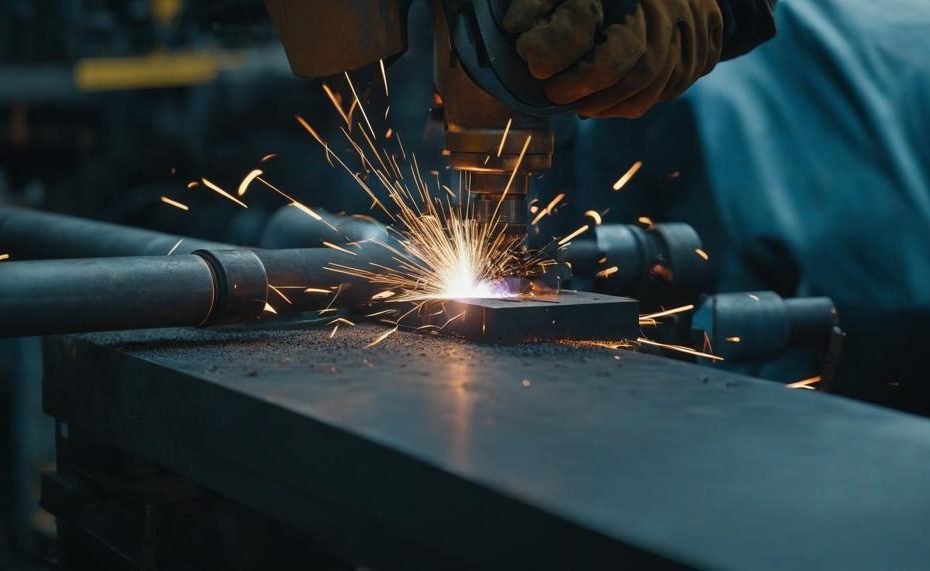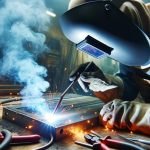If you want to learn more about welding, you might ask, “Can the strong and flexible chromoly steel be MIG welded?” We’re about to open a Pandora’s box full of stories, facts, and expert views because of this question. If you want to work with chromoly, a high-strength metal that is known for being light and very durable, you need to be careful and respectful. This is especially true when MIG welding is involved.
Not only are we going to talk about the basics of MIG welding chromoly in this blog post, we’re going to get really into it. We can help you with everything, from the whys to the hows. Whether you’ve been welding for a long time or are just starting out, what you’re about to learn will teach you something new and maybe even surprise you.
Key takeaways:
- MIG vs. TIG: Unraveling the debate on which welding technique takes the crown for chromoly.
- Prep Work: Why cutting corners with chromoly can lead to disaster.
- Setting the Scene: Optimal settings and gear for welding chromoly with MIG.
- Post-Weld: Handling chromoly after the weld – does it require special treatment?
Grab your helmet and gloves; we’re about to spark some serious interest in the art and science of MIG welding chromoly.
Contents
- 1 What is Chromoly?
- 2 Advantages of Mig Welding Chromoly
- 3 Disadvantages of Mig Welding Chromoly
- 4 What MIG Wire to Use for Chromoly?
- 5 How to Set Up Your Welder for Chromoly Welding?
- 6 Prepping the Metal for Welding
- 7 Step-by-Step Guide on How to Mig Weld Chromoly
- 8 Common Mistakes when Mig Welding Chromoly
- 9 Conclusion
What is Chromoly?
Chromoly, which stands for “chromium-molybdenum steel,” is a steel combination that is unique because it contains both chromium and molybdenum. Chromoly has a lot of unique properties because of these elements. This has made it very popular in many areas, especially soldering. What makes it unique? It is stronger and lighter than regular carbon steel because it has a high strength-to-weight ratio. This quality, along with its excellent resistance to rust, makes chromoly ideal for uses that need to be strong and last a long time, like in cars and spacecraft.
When you talk about MIG welding, chromoly’s importance grows even stronger. Metal Inert Gas (MIG) welding uses a metallic wire electrode and an electric spark to join metals together while a protecting gas keeps them safe. Because it has a high tensile strength and great heat protection, chromoly really shines in this situation. This is because it can handle the high temperatures that come with welding.
Also, chromoly’s composition—especially its low carbon content—lowers the chance of breaking during welding, which protects the joints’ integrity. Because it is very flexible, it can be shaped and bent without losing its strength, which is great for complicated welding jobs.
A clean, debris-free metal surface and choosing the right shielding gas and welding wire are very important for MIG welding chromoly to go well. There should be a strong tensile strength soldering wire and a gas mix that is mostly argon (98%) with a small amount of carbon dioxide (2%) in it.
Below is a succinct table summarizing key chromoly properties and their significance in MIG welding:

| Property | Impact on MIG Welding |
| High strength-to-weight ratio | Enables construction of lightweight, strong structures. |
| Excellent corrosion resistance | Increases durability of welded components in harsh conditions. |
| High tensile strength | Supports welding under stress without deformation. |
| Low carbon content | Reduces risk of welding cracks; enhances weld quality. |
| Good ductility | Facilitates molding and shaping without losing strength. |
In essence, chromoly’s alloy composition makes it a gem in the welding industry, especially for MIG welding. Its blend of strength, durability, and weldability underpins the construction of resilient, high-performance parts in sectors as demanding as automotive and aerospace.
Advantages of Mig Welding Chromoly
Mig welding stands out as a premier choice for fusing Chromoly, thanks to its blend of speed, precision, and versatility. Below is a detailed breakdown of the benefits this method brings to the table, especially when juxtaposed with other welding techniques.
| Benefit | Description | Impact |
| Versatility | Mig welding’s adjustable heat settings cater to Chromoly’s varying thickness and configurations, ensuring adaptability across diverse applications. | Enables welding of complex structures without compromising strength or integrity. |
| Speed | The continuous wire feed mechanism significantly accelerates the welding process, making Mig welding faster than traditional methods. | Efficiency gains in projects, leading to reduced labor time and costs. |
| Weld Quality | Uniform wire feeding and precise heat control result in high-quality, defect-free welds, crucial for Chromoly’s performance in critical structures. | Enhances the durability and reliability of the weld, ensuring safety in high-stress applications. |
| Practicality | Mig welding is user-friendly and less costly in terms of equipment, making it accessible for a wide range of users from amateurs to pros. | Democratizes access to high-quality welding, encouraging broader use in diverse projects. |
| Cleanliness | Minimal splatter and the use of shielding gas contribute to a cleaner weld area, reducing post-weld cleanup. | Saves time and effort in finishing, presenting a neat appearance. |
When welding Chromoly, a material prized for its robustness and lightweight properties, Mig welding’s attributes shine brightly. It not only caters to the metal’s need for precision in heat application but also aligns with the demands for efficiency and quality in modern fabrication.
Disadvantages of Mig Welding Chromoly
When it comes to MIG welding chromoly, a type of steel alloy known for its strength and flexibility thanks to the addition of chromium and molybdenum, several challenges can arise despite its popularity for quick and efficient welding tasks. Here’s a straightforward look at the potential drawbacks:
| Aspect | Drawback | Explanation |
| Heat Management | Overheating Risks | Chromoly’s strength can be compromised by excessive heat, leading to weakened joints. |
| Technical Skill | Requires Expertise | The precision needed for MIG welding chromoly demands high skill levels and experience. |
| Equipment | Specific Requirements | Specialized MIG welders and settings are necessary, which might not be readily available. |
| Preparation | Intensive Prep Work | Cleaning and preheating the material is crucial, adding time and complexity to the welding process. |
| Welding Atmosphere | Shielding Gas Nuances | Selecting the proper shielding gas is critical to prevent porosity and ensure the integrity of the weld. |
| Cooling | Controlled Cooling Required | Rapid cooling can lead to cracking. The weld must cool at a managed rate, often requiring a post-weld heat treatment. |
| Cost | Higher Overall Expense | The additional requirements for equipment, gas, and skilled labor can make MIG welding chromoly more costly. |
In essence, while MIG welding is favoured for its speed and effectiveness when working with chromoly, it’s not without its hurdles. The process requires a delicate balance of heat, skill, and preparation to ensure that the inherent benefits of chromoly, such as its remarkable tensile strength and resistance to deformation, are not diminished.
What MIG Wire to Use for Chromoly?
When it comes to fusing chromoly – a robust and resilient steel alloy – with MIG welding, selecting the optimal wire is paramount. The art of welding demands precision and the choice of consumables can make or break the integrity of the weld.
For chromoly, the consensus among experts leans towards ER70S-2 or ER80S-D2 wires. These selections are not mere happenstance; they’re rooted in the metallurgical compatibility with chromoly’s unique composition. Let’s break it down:
Preferred MIG Wires for Chromoly Welding:
| Wire Type | Characteristics | Why It’s Suitable |
| ER70S-2 | Mild steel, triple deoxidized | Enhances weld pool purity, combating impurities that can weaken the weld. |
| ER80S-D2 | Low alloy steel, high tensile strength | Mirrors chromoly’s strength, ensuring a weld that maintains integrity under stress. |
The ER70S-2 is a sterling choice for its triple deoxidized nature, which purges potential weld pool contaminants, safeguarding the weld’s durability. It’s akin to choosing a sturdy rope for a climber; you want reliability when it matters most. Meanwhile, the ER80S-D2, with its lofty tensile strength, is akin to a well-matched sparring partner for chromoly, capable of holding its own in applications where strength is non-negotiable.
Welding chromoly is akin to crafting a fine timepiece; each component must be chosen with care and precision. The wire you select is the sinew that holds the metal’s bones together. ER70S-2 and ER80S-D2 are not just wires; they are the threads that weave the fabric of reliability and strength in your welding project.
How to Set Up Your Welder for Chromoly Welding?
To effectively set up a welder for chromoly welding, certain essential steps are pivotal. Here’s a breakdown:
Choosing the Right Gas Mixture
- 75% Argon and 25% CO2: Ideal for chromoly due to better penetration and reduced porosity risk.
- Avoid Pure CO2: Leads to subpar weld quality on chromoly.
Voltage and Wire Feed Speed Setting
- Voltage: Adjust according to the chromoly steel’s thickness. Thicker materials require higher voltage.
- Wire Feed Speed: Align with the thickness for smooth bead formation.
Selecting the Appropriate Wire
- ER70S-6 Wire: Recommended for its higher silicon and manganese content, enhancing weld quality on chromoly.
Cleaning and Preparing the Metal
- Surface Preparation: Essential due to chromoly’s heat retention. Clean thoroughly to avoid impurities in the weld.
Preheating the Metal
- Preheating: Reduces warping and improves weld quality, especially for thicker sections.
Post-Weld Cooling
- Controlled Cooling: Ensures the integrity and strength of the weld.
Here’s a visual representation for clearer understanding:
| Step | Action | Reason |
| Gas Mixture | 75% Argon, 25% CO2 | Better penetration, less porosity |
| Voltage and Wire Speed | Adjust based on thickness | Ensures smooth bead and proper penetration |
| Wire Type | ER70S-6 | Reduces cracking and brittleness |
| Surface Prep | Clean thoroughly | Prevents impurities in weld |
| Preheating | Essential for thicker materials | Minimizes warping |
| Cooling | Allow controlled cooling | Maintains weld integrity |
Prepping the Metal for Welding
Prepping chromoly steel for MIG welding isn’t just a good practice; it’s a critical step to ensure the integrity and strength of the weld. Chromoly, a high-strength steel alloy known for its durability and resistance to deformation, demands careful preparation to be welded successfully using Metal Inert Gas (MIG) techniques. Here’s why:
- Cleanliness is Key: Chromoly needs to be free from contaminants like oil, grease, and rust. These impurities can cause porosity in the weld, weakening the joint and making it prone to failure.
- Controlled Heat Input: Proper preparation includes preheating the metal, which is crucial for chromoly. It helps to minimize thermal stress and prevent cracking by ensuring a more uniform temperature throughout the welding process.
- Ensuring Strong Adhesion: A clean, properly prepared surface allows for better adhesion of the weld metal to the base metal. This results in a stronger, more cohesive weld, crucial for the high-stress applications where chromoly is often used.
- Avoiding Weld Defects: Without proper prep, defects such as inclusions, slag entrapments, and excessive spatter can compromise the weld’s integrity. Clean, well-prepared metal surfaces help to avoid these issues.
Step-by-Step Guide on How to Mig Weld Chromoly
To achieve a sturdy and durable weld when MIG welding chromoly, one must follow a precise sequence of steps, utilizing the correct tools and materials. Here’s a guide that simplifies this intricate process into manageable phases, ensuring anyone from a novice to an adept can understand and apply these techniques effectively.
Equipment and Materials Preparation
| Equipment/Material | Description | Use |
| MIG Welder | Adjustable for aluminum/stainless steel | Generates the arc for welding |
| ER70S-6 or ER70S-3 Wire | Specific wire for chromoly welding | Acts as the filler material |
| Shielding Gas (Argon/CO2 or 100% CO2) | Prevents oxidation during welding | Protects the weld area |
Chromoly Preparation
- Clean the Surface: Remove any contaminants like oil, rust, or dirt using a wire brush or solvent. This step is paramount to prevent weld defects.
- Clamp and Align: Securely clamp the chromoly pieces to avoid misalignment during the welding process.
Welding Settings Adjustment
- Set the MIG welder to the correct amperage and wire speed, suitable for the thickness of the chromoly. This precision is crucial for a robust weld.
Welding Technique
- Maintain a consistent arc length and use a steady, controlled motion. If necessary, employ a weaving pattern to distribute the heat evenly and prevent warping.
Post-Welding Care
- Cool Down: Allow the welded piece to cool naturally. Rushing this process can introduce stress and weaken the weld.
- Inspect and Clean: Examine the weld for any imperfections and clean off any slag or spatter with a wire brush.
Common Pitfalls to Avoid
- Avoid using the wrong type of wire or incorrect amperage settings, as they can compromise the weld’s integrity.
- Ensure the chromoly is properly preheated (if necessary) to optimize welding conditions and avoid cracking.
This concise guide ensures a methodical approach to MIG welding chromoly, blending simplicity with depth. The focus is on mastering the fundamentals, optimizing equipment settings, and refining welding techniques for a flawless finish.
Common Mistakes when Mig Welding Chromoly
Avoiding common blunders when MIG welding chromoly isn’t just about getting the weld right; it’s about ensuring the strength and durability of the metal stand the test of time. Here’s a breakdown of the usual pitfalls and how to sidestep them:
| Mistake | Why It’s a Problem | How to Avoid |
| Incorrect MIG Wire Selection | Using the wrong wire can lead to weak welds that are prone to cracking. | Choose a wire that’s compatible with chromoly, typically a 100% argon gas with a wire that matches the chromoly’s composition. |
| Improper Amperage and Wire Speed | Too high or too low settings can cause poor penetration or excessive burn-through. | Adjust the amperage and wire speed according to the thickness of the chromoly and the specific welding conditions. |
| Skipping Preheating | Chromoly benefits from preheating to reduce the risk of warping and cracking. | Gently heat the metal to around 200-250°F (93-121°C) before starting your weld. |
| Neglecting Metal Cleanliness | Contaminants on the metal surface can cause porosity and weaken the weld. | Clean the welding area meticulously to remove any rust, paint, or grease. |
| Incorrect Shielding Gas | Using the wrong gas can lead to contamination and oxidation. | For chromoly, a mix of argon and carbon dioxide or 100% argon is ideal, providing a clean environment for the weld. |
| Rushing the Cooling Process | Fast cooling can introduce stress and cracking. | Let the weld and metal cool naturally, or follow controlled cooling procedures. |
To really master the craft, remember that welding chromoly is as much about feel and experience as it is about following guidelines. Gear up with the right safety equipment, keep your workspace clean, and most importantly, practice.
Conclusion
Navigating the intricacies of MIG welding chromoly reveals a landscape where precision meets strength. Chromoly, a high-strength alloy steel, is renowned for its robust yet lightweight nature, making it a favored material in demanding industries like automotive and aerospace. The art of MIG welding chromoly is not just about merging metal pieces; it’s about crafting connections that withstand the test of time and stress.
MIG welding, with its speedy and efficient process, appears as the knight in shining armor for chromoly, provided the wielder holds the torch of knowledge. The choice between ER70S-2 or ER80S-D2 wires is not mere preference but a strategic decision, ensuring the weld mirrors chromoly’s inherent resilience. The optimal gas mix, primarily argon with a hint of carbon dioxide, becomes the breath of life for the weld, protecting it from the adversities of atmospheric interference.
Yet, the path is fraught with hurdles: the peril of overheating, the demand for expert maneuvering, and the meticulous prep dance. Each step, from cleaning to controlled cooling, is a ritual to honor the metal’s integrity. MIG welding chromoly is akin to alchemy, where every element, from the gas blend to the cooling breeze, must harmonize to transmute base metal into engineering gold.
The tapestry of chromoly MIG welding is woven with threads of technical prowess, metallurgical insight, and a respect for the material’s pedigree.





